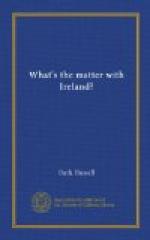“Priests preached sermons Sunday urging the people to withstand the enemy with the same spirit they did in the time of Sarsfield,” said young Alphonsus O’Mara, the mayor of Limerick, whom I met at breakfast. His Sinn Fein beliefs had imprisoned him in his hotel, for his home was beyond the town and he would not ask the British military for a pass. Opposite the breakfast room we could see the drawn blue shades of Limerick’s dry goods store. A woman staggered by with a burlap bag of coal on her shoulders. A donkey cart with a movie poster reading: “Working Under Order of the Strike Committee: God and man,” rolled past. A child hugging a pot of Easter lilies shuffled by. “There’s no idea that the people want communism. There can’t be. The people here are Catholics.”
But a little incident of the strike impressed me with the fact that there were communists among these fervent Catholics. In order to pictorialize the predicament of the Limerick workers to the world through the journalists who were gathered in Limerick waiting the hoped-for arrival of the first transatlantic plane, the national executive council devised this plan. One bright spring afternoon, the amusement committee placed poster announcements of a hurling match that was to be held just outside of Limerick at Caherdavin. About one thousand people, mostly Irish boys and girls, left town. At sunset, two by two, girls with yellow primroses at their waists, and boys with their hurling sticks in their hands, marched down the white-walled Caherdavin road towards the bridge. The bridge guard hooped his arm towards the boat house occupied by the military. Soldiers, strapping on cartridge belts, double-quicked to his aid. A machine gun sniffed the air from the upper story of the boat house. Scotch-and-Soda veered heavily bridgewards. A squad of fifty helmeted constables marched to the bridge, and marked time. But the boys and girls merely asked if they might go home, and when they were refused, turned about again and kept up a circling tramp, requesting admission. Down near the Broken Treaty Stone, in St. Munchin’s Temperance hall, in a room half-filled with potatoes and eggs and milk, women who were to care for the exiles during their temporary banishment, were working. A few of the workers’ red-badged guards came to herald the approach of the workers, and then sat down on a settle outside the hall.
St. Munchin’s chapel bell struck the Angelus.
The red-badged guards rose and blessed themselves.
THE BISHOP ON COMMUNISM
Possibly, I thought, the clergymen of Limerick were hurried into support of red labor. What was the attitude of those who had a perspective on the situation towards communism?
Just outside Limerick, in the town of Ennis in the county of Clare—Clare as well as Kerry has the reputation of shooting down informers at sight—there dwells the most loved bishop in Ireland. The Lenten pastoral of the Right Reverend Michael Fogarty, bishop of Killaloe, was so fervently national that when it was twice mailed to the Friends of Irish Freedom in America it was twice refused carriage by the British government. There was no doubt that he was for Sinn Fein. But how did he stand towards labor?




